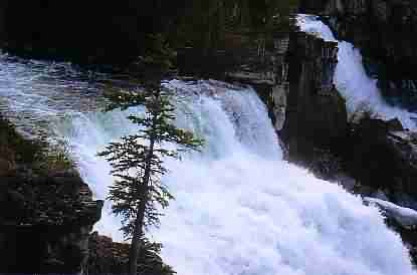A Letter from Jim Martin about Tatsea

La Martre Falls on the La Martre River between Wha Ti and Bechoko, Northwest Territories. (Credit: Sara Jane Wiebe, 2007)
Hi Armin,
As per your request I have provided a few comments about the novel Tatsea...I have appreciated the opportunity to read it, although I really have some trepidation about commenting on it...I am not a particularly critical or sophisticated reader...nor am I any kind of subject expert on Dogrib culture or history.
I heard the story of the frog faced boy, of the Cree who chased the man down the Lac La Martre River and were lured to their deaths over the falls (and it was said still can be seen and heard at the base of the cliff), the young woman who was the first to meet the white traders and the first guns that were brought back to the Dogrib.
I read with growing recognition and excitement these stories placed so skillfully into the single narrative of Tatsea and Ikotsali. It was the story of an unlikely couple that grew to respect and love each other in a dangerous time of war between the tribes. I felt that this is the way it could have been!
Years ago I read Jean Auel's trilogy of stone age people and I remember being fascinated as much by the imaginative story line as by the descriptions of the stone age technology. Although I am unable to comment on the specific "correctness" of Armin's descriptions of the tools, the plants and the creative use of every possible natural element around Tatsea and Ikotsali, it rings true to my experiences. My mother-in-law who lives in Lac la Martre has a freezer filled with plants, roots, bark and berries which can be put into the service of healing most everyday ailments. "Tatsea" is a compelling story. I read it on transit to and from work and as I got into the story, I found it so powerful and unrelenting, I wished my day away to get back on the bus and continue the story! I gave the manuscript to my 12 year old daughter who finished it in 2 days with great enthusiasm and excitement. What else can I say. It is a good, exciting read!
Armin...thank you for the opportunity to read it. I apologize for the lack of critical insight but I hope this is in some way useful to you.
I have lived and worked in the Dogrib communities for the past twenty years and this gives me some context for the stories. I remember as a young teacher having just moved into the community of Lac La Martre, being repeatedly disconcerted by the stories of violence and horror I heard again and again from people when talking about "the way things were before they become the way they are now". It was not until many years later that I learned that these stories did actually have a specific place in time...to people in the community they could easily have happened yesterday as they still provided the context for some occasional, very modern fights with Cree men in the bars in Yellowknife. People told stories of great violence and slaughter between the tribes...I learned the Dogrib have their own Masada...an island in the middle of a northern lake on the Indaa Trail where women and children threw themselves off cliffs to avoid capture by the Cree! I still vividly remember the long silence in the canoes during a school trip as we passed at a safe distance from the "bad medicine" represented by this spirit island. Even the name of Lac La Martre, a community situated on a pristine lake that glistens in the sunlight like a Carribean paradise, reflected the heritage of this past violence. Its real name was Tso Ti or "shit lake". The old Oblate priest said that the French name was really supposed to be Lac la Merde or Lake of Excrement but was changed to the more innocuous Lac la Martre to soothe the outside sensibilities of northern mapmakers...why would anyone ever call this beautiful place excrement lake? ...local people told me it was because of the way the lake looked with the bodies, blood and entrails of Dogrib men, women and children floating in the surf after a particularly vicious attack by Cree marauders. The stories were in stark contrast to the naive visions of paradise that I imagined for a pre-contact aboriginal people. By their own words, the Dogrib elders described a violent, brutal and very dangerous world.
Best of luck with the publication.
Take care
Jim

La Martre Falls (Credit: Armin Wiebe, 1984)